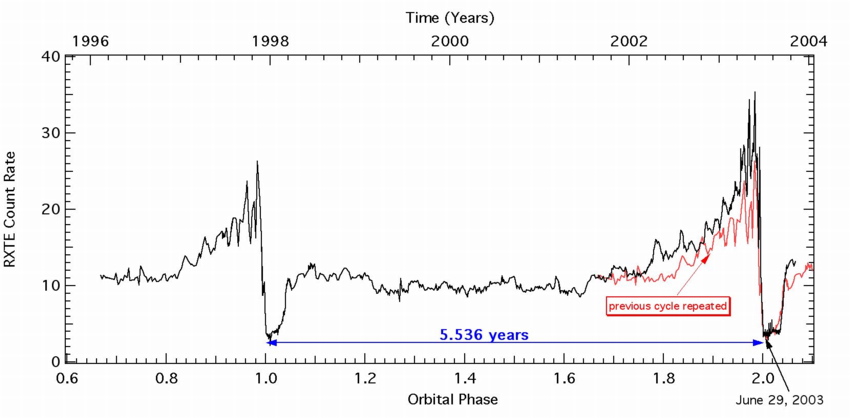
 Credit: M. F. Corcoran
Credit: M. F. Corcoran
Eta Carinae: The Vanishing
Eta Carinae is a monster, egg-shaped star, and an unstable one at that. Its most extreme act was an episode in the middle of the 19th century when the star became for a brief time the second brightest star in the sky (despite a distance of more than 8000 light years) then faded quickly from view. The cause of this episode, known in astronomical lore as the "Great Eruption", is still unknown. For awhile it was believed that the star was blown apart and destroyed, but observations in the 1890s (when the star underwent a "mini-Great Eruption") reassured astronomers that it was still there. The nature of the violent behavior has to do with the star's extreme mass, and extreme brightness, which means that the force of radiation outward is constantly fighting the inward pull of gravity. Although it's been a source of study for more than 400 years, a key piece of evidence about the true nature of the star was only uncovered in the mid-1990's, when Augusto Damineli, a Brazilian astronomer, realized the star undergoes some sort of change every 5.5 years. As it turns out this variation is also observed in X-ray light. The above image shows the
X-ray brightness of Eta Carinae over more than 7 years, as seen by the Rossi X-ray Timing Explorer (RXTE). RXTE shows that the X-ray behavior follows a cycle in which the brightness of the star increases gradually at first, then rapidly and unstably until the X-rays quickly drop off and the star fades from X-ray view for about 3 months. These X-ray "eclipses" recur like clockwork every 2,022 days and some astronomers believe this means that Eta Carinae is really two stars, not one. The most recent such "Event" occurred in the summer of 2003, when Eta Carine was subject of a worldwide observing campaign. Interestingly, the X-ray brightness of the star overall is increasing with time; perhaps Eta Car is getting ready to blow its top once again?
Last Week *
HEA Dictionary * Archive
* Search HEAPOW
* Education
Each week the HEASARC
brings you new, exciting and beautiful images from X-ray and Gamma ray
astronomy. Check back each week and be sure to check out the HEAPOW archive!
Last modified Tuesday, 27-Feb-2024 10:10:04 EST


